RESEARCHING YOUR FAMILY HISTORY | ||||||
| | ||||||
| | ||||||
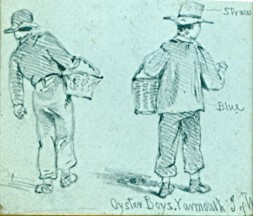 | | 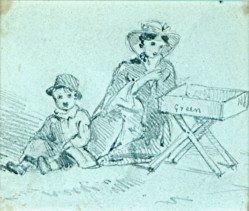 | ||||
| | ||||||
| | ||||||
| | 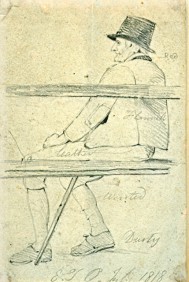 | | ||||
| | ||||||
| | ||||||
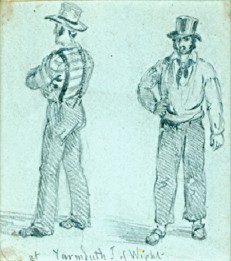 | | 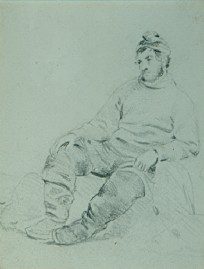 | ||||
| | ||||||
| A series of sketches dated 1818 Isle of Wight Record Office Illustrations Collection un-catalogued | ||||||
| | ||||||
| | ||||||
| Parish Register Background Information | ||||||
| | ||||||
| The surviving parish registers for the island for baptism, marriage and burial records are held in the Isle of Wight Record Office. The information a family historian can glean from these registers will depend on the date: the further you proceed back in time the less information is available. A brief outline of the history for recording parish entries is detailed below. It is useful for any family historian to understand the system that was in place and the information that is available for a given period in time. | ||||||
| In 1538 Thomas Cromwell ordered the Vicar or Rector of each parish to record in a book every christening marriage and burial, which took place in his church, and to keep these registers locked up in a "sure coffer". These early registers were often written on loose sheets and in 1598 clergy were instructed to copy them up properly into parchment books. This office has registers for nine parishes with entries before 1598 but of these the vast majority had their entries copied retrospectively and very neatly when the parchment book was purchased. | ||||||
| | ||||||
| These early registers give very little detail. In the case of a baptism the child is named, the date of the baptism is recorded and the name of the father is given, but the name of the mother is not always mentioned. A marriage entry would give the name of the bride, the name of the groom and the date of the wedding. Occasionally an additional piece of information might be recorded: for example one of the parties might be described as "widower" or "widow" thus indicating a previous marriage. A burial would simply give the name of the person, the date, and from time to time an age. If the person died under special circumstance - for example if they were the victim of an accident or the plague this might be noted. | ||||||
| | ||||||
| From 1598 the clergy of each parish were required to send annual returns of the baptism, marriage and burial entries to the diocesan register. These copies are known as Bishops Transcripts and prove of value where they exist and a parish register has not survived. These transcripts are held by the Hampshire Record Office but few survive before 1780. | ||||||
| | ||||||
| In 1711 an Act was passed ordering the keeping of proper register books with ruled and numbered pages. | ||||||
| | ||||||
| Due to the increasing number of illegal marriages Hardwicke's Marriage Act was passed in 1754. Records were to be kept for both the reading of the banns (to ensure the couple were free to marry) and of the marriage itself. Banns announce the intention of two people to marry and were called in both the groom's and bride's parish, so that the forthcoming marriage could be challenged if it would be invalid. Separate marriage registers were to be kept. These comprised printed forms, with additional information to be recorded as follows: the status of both the bride and groom (i.e. bachelor, spinster, widower, widow), the parish to which both the bride and groom belonged. This would be recorded as "of this parish" if both parties lived in the parish where the marriage was to take place (this can be misleading because residency was only required for a three week period prior to the event). We can also learn whether the marriage took place with "consent of parents" or "consent of friends" (if the groom and/or bride were under the legal age). Both the groom and bride were required to sign their name in the register (or make their mark) in the presence of two witnesses who were also required to sign their name or make their mark. Marriage licences could be granted in place of the issuing of banns. There were various reasons why a licence might be applied for. They enabled marriage in a building that was not a parish church, or a marriage at a time of year such as Lent, which was traditionally not one when marriages were held. Papers relating to the issuing of licences will be in the diocesan archives at the Hampshire Record Office. From 1754 until 1837 all marriages other than those for Jews and Quakers had to be held in an Anglican church. The Isle of Wight Record Office has included the Hampshire Marriage Licenses in their surname index. | ||||||
| | ||||||
| In 1763 the minimum age for marriage was fixed at 16. Prior to this girls could marry as young as 12 and boys at 14. A special dispensation could be obtained which allowed for a marriage to take place where the parties were younger. | ||||||
| | ||||||
| Rose's Act of 1812 required that separate registers were kept for baptisms, marriages and burials. Baptisms would now include the name of the child, the names of the parents, the occupation of the father, and the place of residence, although this might only be the village in which they lived rather than a property name. Burial registers were to include the age and abode of the deceased. | ||||||
| | ||||||
| By 1837 there was a growing interest by the government in knowing about birth and death rates, so that population growth could be studied. However there were growing numbers of non-conformists, which made an Anglican church based system of registration inadequate. As a result, in 1837, civil registration became a legal requirement and every, birth, marriage and death had to be registered. Vicars of Anglican churches continued to record in church registers the baptisms, marriages and burials that took place in their parish and non-conformist chapels kept registers of baptisms and burials. However, until 1899, non-conformist chapels were not licensed to perform marriage ceremonies without a Registrar being present. The marriage registers for these denominations for the period 1837-1899 can only be accessed via the Registrar's Office, and are incorporated alongside the entries for civil marriages. Marriage registers from 1837 recorded additional information: the name of both the groom's and bride's fathers was entered together with their occupation. “Deceased" was noted if they were no longer alive. The groom's occupation was given, and the bride’s if applicable. Their ages were also recorded (or noted as “of full age” which at this date was 21 years or over). The bride and groom were still required to sign their names in the register in the presence of their two witnesses. There were two copies of these registers - one held in the parish church the other in the office of the Registrar. | ||||||
| | ||||||
| A list of Parish Registers and their covering dates can be accessed via the side bar. For some parishes there are gaps in these covering dates. This may be due to loss or damage to the register or the incumbent may not have written up all of the entries. There are however two historical events worth considering, the first of which is the Commonwealth period (1649-1653) during which time Civil Registers were kept and maintained by appointed officers. An intention to marry could be stated at a Market Cross or the couple could go to a Justice of the Peace to be legally joined. After the Commonwealth Period local clergy entered these marriages retrospectively but some refused and a second marriage took place. Children born as a result of “civil marriages” were often seen as illegitimate if a remarriage did not take place this explains the use of "alias" in some parish entries. There are no known original examples of these civil registers for the island. There are marriages recorded in island parish registers during this period, for example the parish register for Newport records weddings in the presence of the "register" for the commonwealth period right through to 1660. A few parishes also record births as opposed to baptisms in this period. The second time period falls between 1694 and 1706 when the register entries were used as a tax to raise money for a war against France. The following fees were payable: for a marriage 2s 6d, for a burial 4s and for a birth 2s. There was also a tax on all unmarried men of 1s a year and a payment of 6d for every child who was not baptised. Clergy who did not record a birth were to be fined £2.00. This tax was abandoned due to the difficulty in enforcement but resulted in some entries not being recorded due to lack of funds. | ||||||
| | ||||||
| Samples of parish register entries can be seen on our web site under "Our Collections" then "Parish Records and Registers". | ||||||
| | ||||||
| | ||||||
| Consolidated Card Index to Isle of Wight baptism, marriage and burial records | ||||||
| | ||||||
| The Isle of Wight Record Office has a card index to all baptisms, marriages and burials from 1539-1900. This index is arranged by surname and then chronologically within each surname group. Although described as a card index the cards are actually full transcripts of the parish register entries for both baptisms and burials. Marriages are more complicated. For the period up to 1754 the cards act as transcripts. From 1754 to 1837 the cards omit the witness names and do not reflect whether the bride and groom could sign their name. From 1837 onwards the marriage cards take the form of an index but photocopies of the parish registers are kept in the search-room under parish thus making the complete information freely available. Where a parish register has not survived and a Bishop’s Transcript (BTs) is available these are included in our index although the originals are held at Hampshire Record Office. | ||||||
| There are further indices for marriages 1900-1910, baptisms 1900-1920 and burials 1900 - late 1900s depending on the parish (this burial index is available on line - go to the parish pages of this web site). There is also an index to civil cemetery burials, which date from 1858, this index covers the period 1858 to the late 1900s and an index to the Crematorium registers from 1965 to the late 1900s (there were no cremations on the island prior to 1965). | ||||||
| | ||||||
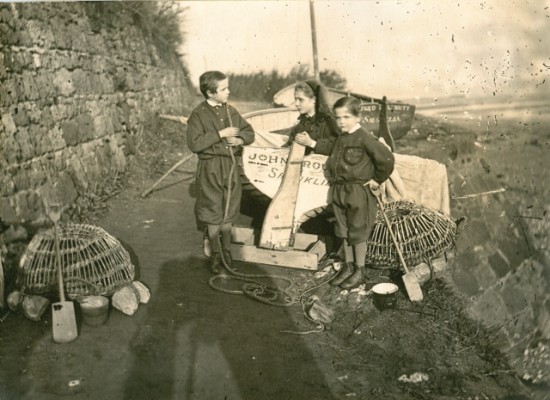 | ||||||
| | ||||||
| This small boat bears the name "John Prouten Shanklin" | ||||||
| The Prouten family operated the Chine Inn during the period c1850 – c1880 | ||||||
| Ref: Isle of Wight Record Office Illustrations collection un-catalogued | ||||||
| | ||||||
| The pre 1900 original parish registers although housed in the Record Office are not available for consultation. However, most have been microfilmed and these can be consulted to obtain the witness names and signatures for the 1754-1837 marriages and copies of relevant entries can be made. Some post 1900 registers have been microfilmed and can be accessed in this format. For later deposits where no microfilm has been made the original register can be viewed on completion of a document request slip bearing the relevant reference number. | ||||||
| | ||||||
| Miscellaneous Surname Index | ||||||
| | ||||||
| This surname index includes references to documents held in the Record Office for which catalogues have been produced. These mostly comprise title deeds and leases held in our estate collection but one of the most useful sources that can be accessed by using this index is the 1834 List of Paupers, which forms part of the House of Industry or Workhouse records. | ||||||
| | ||||||
| There are also references to documents held in other Repositories such as the Poll Tax* (1378), Ship Money* (1637) and Lay Subsidies* (1522, 1547, 1563, 1568, 1571, 1589-91, 1594, 1598 and 1600) together with Feet of Fines* the originals of which are held in the National Archive (TNA). | ||||||
| | ||||||
| Wills are also referenced in this section. Although the originals are held at Hampshire Record Office microfiche copies for some, but not all, wills are held in the IWRO. These microfiche do not include Letters of Administration, which were the legal process when a person died intestate, or Inventories. More information on wills prior to 1858 and the Principal Probate Registry (for wills after 1858) is given in “Our Collections” section of the web site. | ||||||
| | ||||||
| * See Glossary: to access from home page click our collections select glossary | ||||||
| | ||||||
| Research from 1837 | ||||||
| | ||||||
| The original parish registers are held on deposit here at the Isle of Wight Record Office and a card system allows for easy access to the information contained within these registers. Before commencing your family history you might find it useful to compile a tree commencing with your own personal information, then progressing backwards to your parents and grandparents. Include in this initial "tree" your siblings and those of your parents and grandparents. Once you have made a note of all the known information you can commence your research by consulting the baptism, marriage and burial records. As you progress further back in time you will find that recording all the children within a family group will reveal the number of times a family moved from parish to parish. This is especially relevant in the case of agricultural workers who might move from farm to farm at Michaelmas each year. | ||||||
| | ||||||
| Having built up a picture of a family group it is then useful to consult census returns. The first census that survives for the island is dated 1841. However, as with baptism, marriage and burial records, census records need to be consulted by referring to the most recent first, and then working backwards using the census returns in tandem with the baptism, marriage and burial information you have found. | ||||||
| | ||||||
| There are surname indices for the 1841, 1851, 1871, 1881 and 1891 returns. Those for 1861 and 1901 have not yet been indexed locally. | ||||||
| | ||||||
| If you are unable to find a baptism, marriage or burial record for an individual then from 1837 you will find it helpful to consult the civil records for births, marriages and deaths. These have been indexed by the Isle of Wight Family History Society. | ||||||
| | ||||||
| | ||||||
| Research prior to 1837 | ||||||
| | ||||||
| Family history research prior to 1837 becomes more difficult for two reasons. Firstly less information is recorded in the registers and secondly there is no civil registration in the form of births, marriages and deaths. Remember, that the church was interested in the religious ceremonies for baptism, marriage and burial. | ||||||
| | ||||||
| Another useful source included in our marriage index for the period prior to 1837 are the Marriage Allegations. These are relevant when a licence to marry was issued. This licence was issued after the parties made an allegation and bond and will include additional information to the marriage register (exact age, occupation of groom and name of the bondsmen). The original documents are held at Hampshire Record Office | ||||||
| | ||||||
| It is possible to trace your family back to the 1600s and sometimes earlier using baptism, marriage and burial records in conjunction with other types of record, but only where the relevant registers survive and this is easier where the surnames are found less frequently. Remember to always check baptisms against burial registers, as infant mortality rates were high in this period. | ||||||
| | ||||||
| | ||||||
| Other sources held in the Isle of Wight Record Office | ||||||
| | ||||||
| Whilst compiling your family tree you might like to consult other collections held in the Record Office, which would give you more information on your ancestors, their lives, and the environment in which they lived. | ||||||
| | ||||||
| Listed below are various collections. To access catalogue descriptions and covering dates return to home page and click on "Our Collections" | ||||||
| | ||||||
| Borough Records Directories Education and Schools Electoral Registers (from 1920 only) and Poll Books Estate Hospital and Asylum House of Industry (Workhouse) Monumental Inscriptions Newspapers Ordnance Survey Maps Parish Records (other than registers i.e. Poor Relief) Prisons Quarter and Petty Session Records Tithe Maps Wills | ||||||
| | ||||||
| Some of the above collections include individual volumes for which there are surname indices. The following is a list of indices and covering dates that you might find useful: | ||||||
| | ||||||
| Apprenticeship Records House of Industry 1802-33 Coroners Records 1850-1864 1886-1906 Crematorium Registers 1965-late 1900s Electoral Registers 1920 1921 1925 1929 1938 1933 1947 Hearth Tax (Printed Volume the original documents are held in the TNA) 1664-1674 Monumental Inscriptions (parish grave-yards only – not complete) Newchurch Rate Books 1846 1856 1866 Newport Borough Records: Certificates of Conviction 1734-1833 Newport Borough Records: Indictments 1768-1836 Newport Borough Records: Memorials and Petitions 1730-1808 Newport Borough Records: Oaths and Declarations 1734-1833 Newport Borough Records: Sacrament Certificates 1673-1827 Paupers, List of 1834 (card index) Pauper Emigration (House of Industry) 1830-1842 Pauper Lists 1868 1875 and 1882 Petty Sessions: Newport 1837-1919 (some gaps) Petty Sessions: County 1819-1857 | ||||||
| In addition we have an index to Alehouse Licences arranged by the name of the pub and an index to Cowes Registry of Shipping arranged by Boat. | ||||||
| | ||||||
| Preparing for your Visit | ||||||
| | ||||||
| When you visit the Isle of Wight Record Office for the first time our search room assistant will explain the card index to you together with census and civil burial records. If you have any specific queries relating to your research they will be pleased to answer your questions or point you in the right direction to access further indices and catalogues. Please remember to bring all relevant papers with you. The success of your visit will be dependent on how you manage your time so consult our website to see what is available. Where catalogues are online take a note of document references that you wish to consult. You can save further time by ordering documents by email in advance of your visit. If you are uncertain as to whether a particular document will answer your query please send us an email. We will be pleased to offer advice and guidance but allow at least 3 days for us to process your enquiry as we receive many requests for information. Finally, remember to book a microfilm with print facilities if you wish to consult parish registers, census or newspapers. | ||||||
| | ||||||
| We hope that you will find this information helpful and that you will enjoy your visit to our office. | ||||||
| | ||||||
| | ||||||
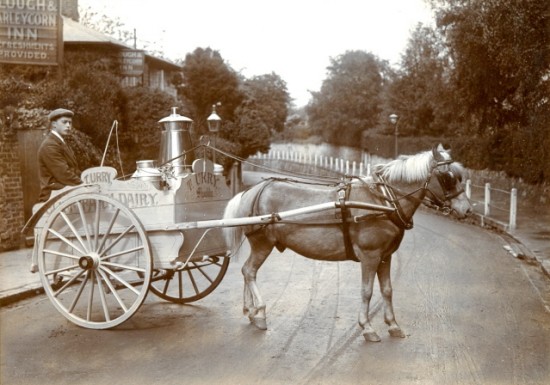 | ||||||
| | ||||||
| This photograph was taken outside of the Plough and Barleycorn public house in Shanklin and shows the milk float of T. Urry Cliff Farm Dairy who delivered milk in the Shanklin area c1900 | ||||||
| Ref: Isle of Wight Illustrations Collection Un-catalogued | ||||||
Page last updated on: 13/05/2010





